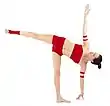Dvi Pada Sirsasana
Dvi Pada Sirsasana[lower-alpha 1] or Both Feet Behind the Head pose is an advanced seated balancing asana in hatha yoga.
Etymology
The name of this pose, Sanskrit द्विपाद शीर्षासन dvi pāda śīrṣāsana comes from "dvi" meaning "two", "pada" meaning "foot", "sirsa" meaning "head", and "asana" meaning "posture" or "seat".[1]
In the 19th century Sritattvanidhi, a pose named Aranyachatakasana, the Forest Sparrow Pose, is described and illustrated. It matches Light on Yoga's description of Dvi Pada Sirsasana.[2]
In Sivananda Yoga, as described by Vishnudevananda Saraswati, a pose named "Dwipada Sirasan" (sic) is illustrated, but the pose shown resembles Yoganidrasana.[3]
Description
In Dvi Pada Sirsasana, a balancing seated position, the feet are crossed behind the head and the hands are held in prayer position in front of the chest. B. K. S. Iyengar rates its difficulty as 24 out of 60, stating that balance in the pose is hard as there is a tendency to fall backwards.[4] He suggests leaving the pose by lifting into Tittibhasana.[4] In Ashtanga Vinyasa Yoga, the pose is in the intermediate series, and it is both preceded and followed by Tittibhasana.[1] The pose can be viewed as a variant of Kurmasana (tortoise), and is said to be calming for practitioners able to achieve the extreme hip rotation involved.[5]
Claims
Twentieth century advocates of some schools of yoga, such as B. K. S. Iyengar, made claims for the effects of yoga on specific organs, without adducing any evidence.[6][7] Iyengar claimed that this pose benefits the abdominal organs "quickly", and like Yoganidrasana "tones the kidneys, liver, spleen, intestines, gall bladder, prostates [sic] and the urine bladder", freeing them from disease with "continued practice". He claimed it "exercises the gonads" and rests "the nerves", storing "energy .. for better thinking and better work".[4]
See also
- Navasana - another balancing seated position
- Yoganidrasana - a reclining pose with a similar leg position
Notes
- Also spelt "Dwi Pada Shirshasana" and other combinations.
References
- "Dvi-Pada Shirshasana". Ashtanga Yoga. Retrieved 28 January 2019.
- Sjoman 1999, pp. 82 and plate 15, pose 89.
- Vishnudevananda 1988, pp. plates 71.
- Iyengar 1979, pp. 307-308.
- Vas, Louise (13 June 2015). "Dwi Pada Sirsasana / Both Legs Behind the Head Pose". Asana International Yoga Journal. Retrieved 28 January 2019.
- Newcombe 2019, pp. 203-227, Chapter "Yoga as Therapy".
- Jain 2015, pp. 82–83.
Sources
- Iyengar, B. K. S. (1979) [1966]. Light on Yoga: Yoga Dipika. Unwin Paperbacks. ISBN 978-1855381667.
- Jain, Andrea (2015). Selling Yoga : from Counterculture to Pop culture. Oxford University Press. ISBN 978-0-19-939024-3. OCLC 878953765.
- Newcombe, Suzanne (2019). Yoga in Britain: Stretching Spirituality and Educating Yogis. Bristol, England: Equinox Publishing. ISBN 978-1-78179-661-0.
- Sjoman, Norman E. (1999). The Yoga Tradition of the Mysore Palace. Abhinav Publications. ISBN 81-7017-389-2.
- Vishnudevananda, Swami (1988) [1960]. The Complete Illustrated Book of Yoga. Three Rivers Press. ISBN 0-517-88431-3.
_from_Jogapradipika_1830_(detail).jpg.webp)
